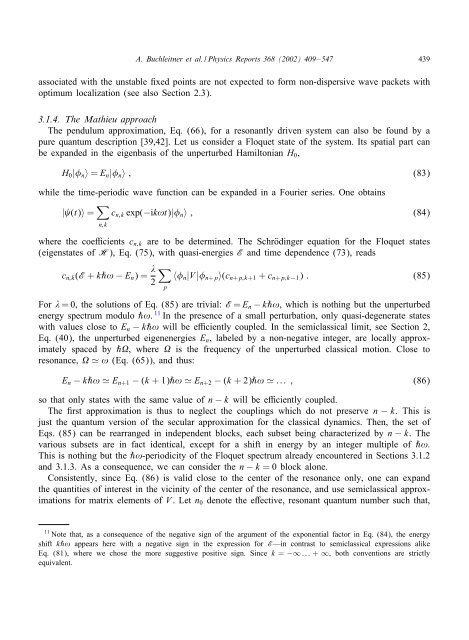Non-dispersive wave packets in periodically driven quantum systems
Non-dispersive wave packets in periodically driven quantum systems
Non-dispersive wave packets in periodically driven quantum systems
Create successful ePaper yourself
Turn your PDF publications into a flip-book with our unique Google optimized e-Paper software.
A. Buchleitner et al. / Physics Reports 368 (2002) 409–547 439<br />
associated with the unstable xed po<strong>in</strong>ts are not expected to form non-<strong>dispersive</strong> <strong>wave</strong> <strong>packets</strong> with<br />
optimum localization (see also Section 2.3).<br />
3.1.4. The Mathieu approach<br />
The pendulum approximation, Eq. (66), for a resonantly <strong>driven</strong> system can also be found by a<br />
pure <strong>quantum</strong> description [39,42]. Let us consider a Floquet state of the system. Its spatial part can<br />
be expanded <strong>in</strong> the eigenbasis of the unperturbed Hamiltonian H0,<br />
H0| n〉 = En| n〉 ; (83)<br />
while the time-periodic <strong>wave</strong> function can be expanded <strong>in</strong> a Fourier series. One obta<strong>in</strong>s<br />
| (t)〉 = <br />
cn;k exp(−ik!t)| n〉 ; (84)<br />
n;k<br />
where the coe cients cn;k are to be determ<strong>in</strong>ed. The Schrod<strong>in</strong>ger equation for the Floquet states<br />
(eigenstates of H), Eq. (75), with quasi-energies E and time dependence (73), reads<br />
<br />
cn;k(E + k˝! − En)=<br />
2<br />
〈 n|V | n+p〉(cn+p;k+1 + cn+p;k−1) : (85)<br />
p<br />
For = 0, the solutions of Eq. (85) are trivial: E = En − k˝!, which is noth<strong>in</strong>g but the unperturbed<br />
energy spectrum modulo ˝!. 11 In the presence of a small perturbation, only quasi-degenerate states<br />
with values close to En − k˝! will be e ciently coupled. In the semiclassical limit, see Section 2,<br />
Eq. (40), the unperturbed eigenenergies En, labeled by a non-negative <strong>in</strong>teger, are locally approximately<br />
spaced by ˝ , where is the frequency of the unperturbed classical motion. Close to<br />
resonance, ! (Eq. (65)), and thus:<br />
En − k˝! En+1 − (k +1)˝! En+2 − (k +2)˝! ::: ; (86)<br />
so that only states with the same value of n − k will be e ciently coupled.<br />
The rst approximation is thus to neglect the coupl<strong>in</strong>gs which do not preserve n − k. This is<br />
just the <strong>quantum</strong> version of the secular approximation for the classical dynamics. Then, the set of<br />
Eqs. (85) can be rearranged <strong>in</strong> <strong>in</strong>dependent blocks, each subset be<strong>in</strong>g characterized by n − k. The<br />
various subsets are <strong>in</strong> fact identical, except for a shift <strong>in</strong> energy by an <strong>in</strong>teger multiple of ˝!.<br />
This is noth<strong>in</strong>g but the ˝!-periodicity of the Floquet spectrum already encountered <strong>in</strong> Sections 3.1.2<br />
and 3.1.3. As a consequence, we can consider the n − k = 0 block alone.<br />
Consistently, s<strong>in</strong>ce Eq. (86) is valid close to the center of the resonance only, one can expand<br />
the quantities of <strong>in</strong>terest <strong>in</strong> the vic<strong>in</strong>ity of the center of the resonance, and use semiclassical approximations<br />
for matrix elements of V . Let n0 denote the e ective, resonant <strong>quantum</strong> number such that,<br />
11 Note that, as a consequence of the negative sign of the argument of the exponential factor <strong>in</strong> Eq. (84), the energy<br />
shift k˝! appears here with a negative sign <strong>in</strong> the expression for E—<strong>in</strong> contrast to semiclassical expressions alike<br />
Eq. (81), where we chose the more suggestive positive sign. S<strong>in</strong>ce k = −∞ ::: + ∞, both conventions are strictly<br />
equivalent.











